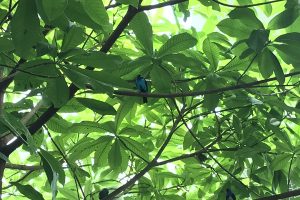By Jamison Ervin and Midori Paxton
We are facing a planetary emergency – a nature crisis, a climate crisis, and an inequality crisis all at once. Yet the world’s level of ambition to tackle our nature crisis to date has been lackluster, with a recent report highlighting that the world has failed to achieve most of the global biodiversity ambitions that the world agreed to in 2010, as part of a decade-long strategic plan for nature.
The result of low levels of leadership and political will in implementing the global plan, along with ever increasing threats to ecosystem and biodiversity coming from economic sectors, has been predictable – a recent report on the state of biodiversity found that the world has lost 68% of all wildlife populations since 1970.
Funding an ambitious post-2020 global diversity framework requires eliminating “negative money.”
To fully respond to this emergency, we need bold ambition, commitment, and action at all levels, from local to global, and across different sectors and constituencies. We need a multi-pronged “whole-of-society approach” to redefine our relationship with nature towards constructing a nature-based planetary safety net.
This article provides updates on progress in five areas.
Committing to Financing Nature
Funding an ambitious post-2020 global biodiversity framework will require a significant increase in financial resources from all sources, including official development assistance, governments’ domestic budgets, climate financing directed to nature-based solutions, philanthropies, corporations, and new sources of revenue.
It also requires eliminating “negative money.” For example, hundreds of millions of dollars are spent every year as agriculture, fisheries, and other subsidies to incentivize activities that degrade or destroy nature. All told, the finance gap for protecting 30% of the planet is about USD700 billion a year. However, a new report shows that this finance gap is not as large as it seems – it accounts for just under one percent of global GDP, and is a tiny fraction of the USD5.2 trillion we spend in fossil fuel subsidies. Moreover, the benefits of protecting nature outweigh the costs by at least 5:1. The best investment ever!
Reversing Biodiversity Loss by 2030 Through Global Commitment
Global, national, and sub-national leaders can no longer ignore our planetary crisis. Indeed, more than 1,700 jurisdictions have already declared a climate emergency. Now world leaders have begun to mobilize around a pledge for nature. More than 50 heads of state have already signed a pledge for nature, and 30 more are in the process of endorsing.
Among other statements, this pledge includes a recognition of the nature crisis, and calls for an expression of the need for a profound re-commitment from world leaders to take urgent action. To accompany this commitment, the Club of Rome has developed a concrete plan to emerge from our emergency.
Creating a Nature-Based Planetary Safety Net
The year 2021 will see the agreement by the world’s governments on a bold biodiversity framework through 2030, with an eye towards a planet in harmony with nature by 2050.
Building on the indivisible relation between the wellbeing of people and the wellbeing of nature, the 15th Conference of Parties of the Convention on Biological Diversity (CBD COP 15) will begin by looking back to the past decade, identifying reasons for hope in national and local action on biodiversity. COP 15 will then look forward, identifying key elements required for achieving success, including bold political will, coherent and aligned government policies, integration and alignment of a wide range of economic sectors, adequate resource mobilization, and decisive action, among others.
Greening Covid-19 Recovery Efforts and Creating Green New Deals
COVID-19 has taught us that business as usual is no longer an option. This crisis highlights the socio-economic threats and costs posed by our planetary emergency, and offers an opportunity to accelerate the transition to more inclusive, greener, and more resilient economies. Decisions made now on how to stimulate growth, respond to the COVID-19 pandemic crisis, and prevent the next pandemic will determine the future health, well-being, and stability of both people and the planet.
To take action, countries can:
- “green” their stimulus packages and longer-term national recovery plans;
- promote green public work programs;
- redirect harmful fossil fuel and agricultural subsidies;
- integrate nature-climate concerns into agriculture, water resources, forestry, tourism, industry, mining, energy, and infrastructure; and
- promote sustainable public/private finance and investments.
Mapping Nature for People and Planet
More than 2,200 satellites circle the earth, enabling humanity to monitor the planet in ways never imagined possible. Enabled by the UNDP-led UN Biodiversity Lab, governments are beginning to use spatial data from these satellites, and combine these datasets with local and national data to generate new insight.
Supported by UNDP, and with funding from the Gordon and Betty Moore Foundation, the Government of Sweden, and One Earth, five governments – Uganda, Costa Rica, Peru, Kazakhstan and Colombia – have initiated a new process, called Mapping Nature For People and Planet: Essential Life Support Areas. Using satellite data, local and national data, and the principles of systematic conservation planning, these governments are able to pinpoint where actions on nature protection, restoration, and sustainable management will help them meet their nature-dependent national development goals, especially for water, food, climate, livelihoods, safety, and biodiversity. As Carlos Manuel Rodriguez, the new head of the Global Environment Facility (GEF), and Francis Ogwal, co-chair of the working group on the post-2020 global biodiversity framework, explain in a recent blog, such maps are an essential component for planning, implementing, and monitoring bold ambition and action on nature.
2020 was supposed to be a ‘Super Year for Nature.’ But even though all major biodiversity events have been postponed or cancelled, the recent gains in these five trends give us reasons for hope. To learn more, and for a dose of hope, visit www.NatureForLifeHub.org.
The authors of this guest article are Jamison Ervin, Manager at the UN Development Programme’s Nature for Development Global Programme, and Midori Paxton, Head of Ecosystems and Biodiversity, UNDP.

